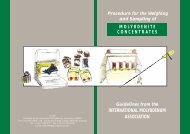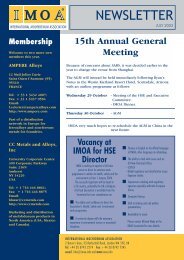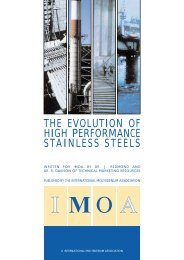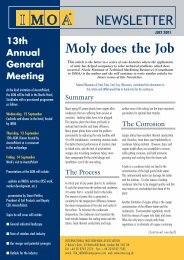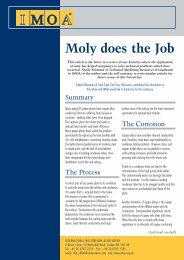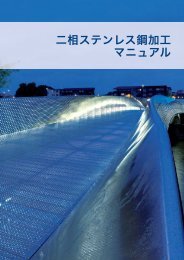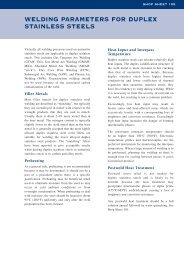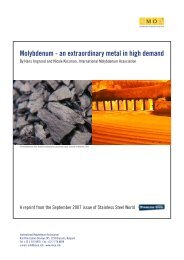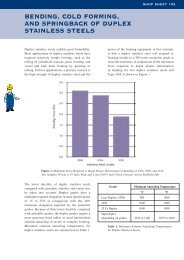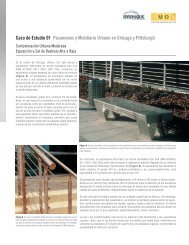Assaying of Moly Oxide - IMOA
Assaying of Moly Oxide - IMOA
Assaying of Moly Oxide - IMOA
You also want an ePaper? Increase the reach of your titles
YUMPU automatically turns print PDFs into web optimized ePapers that Google loves.
Procedure for the <strong>Assaying</strong> <strong>of</strong><br />
TECHNICAL GRADE<br />
MOLYBDENUM OXIDE<br />
GUIDELINES FROM<br />
R
INTRODUCTION<br />
This Guideline on good practice in relation to the <strong>Assaying</strong> <strong>of</strong><br />
<strong>Moly</strong>bdenite Concentrates is one <strong>of</strong> a six part series on<br />
Weighing, Sampling and <strong>Assaying</strong> which has been drawn up and<br />
published by the International <strong>Moly</strong>bdenum Association for the<br />
benefit <strong>of</strong> its members and the industry at large.<br />
The aim <strong>of</strong> the <strong>IMOA</strong> Sampling and <strong>Assaying</strong> Committee was to<br />
prepare worldwide industry guidelines to improve consistency<br />
and quality in Weighing, Sampling and <strong>Assaying</strong> procedures for<br />
<strong>Moly</strong>bdenite Concentrates, Technical Grade <strong>Moly</strong>bdenum <strong>Oxide</strong><br />
and Ferromolybdenum.<br />
The full series includes:<br />
Procedure for the Weighing and Sampling <strong>of</strong><br />
<strong>Moly</strong>bdenite Concentrates.<br />
Procedure for the Weighing and Sampling <strong>of</strong> Technical<br />
Grade <strong>Moly</strong>bdenum <strong>Oxide</strong>.<br />
Procedure for the Weighing and Sampling <strong>of</strong><br />
Ferromolybdenum.<br />
Procedure for the <strong>Assaying</strong> <strong>of</strong> <strong>Moly</strong>bdenite<br />
Concentrates.<br />
Procedure for the <strong>Assaying</strong> <strong>of</strong> Technical Grade<br />
<strong>Moly</strong>bdenum <strong>Oxide</strong>.<br />
Procedure for the <strong>Assaying</strong> <strong>of</strong> Ferromolybdenum.
Procedure for the Chemical Analysis <strong>of</strong><br />
TECHNICAL GRADE MOLYBDENUM OXIDE<br />
1.<br />
SCOPE AND FIELD OF APPLICATION<br />
This guideline procedure specifies a chemical method which is specifically<br />
designed to be applicable for the determination <strong>of</strong> total molybdenum in<br />
technical grade molybdenum oxide within the normal ranges <strong>of</strong> this<br />
material.<br />
2.<br />
PRINCIPLE<br />
Oxidation <strong>of</strong> sample, dissolution <strong>of</strong> molybdenum using ammonia, separation<br />
<strong>of</strong> iron and silica by filtration, prior to precipitation, and gravimetric<br />
determination as lead molybdate.<br />
Tungsten and vanadium interfere and the procedure may require correction<br />
for these to the final figure, as they co-precipitate with the lead molybdate,<br />
causing enhancement <strong>of</strong> the final molybdenum assay.<br />
WARNING:- This Guideline Procedure involves hazardous<br />
materials, operations and equipment. It is the responsibility <strong>of</strong><br />
the user <strong>of</strong> this Guideline Procedure to establish appropriate<br />
health and safety practices and determine the applicability <strong>of</strong><br />
regulatory limitations prior to use.<br />
3
3.<br />
REAGENTS<br />
Use only reagents <strong>of</strong> recognised analytical grade, and only distilled water or<br />
water <strong>of</strong> equivalent purity.<br />
3.1 Hydrochloric acid (1.18 S.G.)<br />
3.2 Nitric acid (1.46 S.G.)<br />
3.3 Ammonia solution (0.88 S.G.)<br />
3.4 Ammonia wash solution (20%):<br />
Dilute 200 ml ammonia solution (3.3) to 1000 ml with water.<br />
3.5 Hydrogen peroxide (20 vol %)<br />
3.6 Glacial acetic acid (1.05 S.G.)<br />
3.7 Lead acetate solution:<br />
Dissolve 40 g <strong>of</strong> lead acetate in 500 ml water. Add 5 ml glacial acetic acid<br />
(3.6) and dilute to 1000 ml with water.<br />
3.8 Ammonium acetate solution (20%):<br />
Dissolve 200 g <strong>of</strong> ammonium acetate in 500 ml water. Add 10 ml <strong>of</strong><br />
glacial acetic acid (3.6) and dilute to 1000 ml with water.<br />
3.9 Ammonium acetate wash solution:<br />
Dilute 200 ml <strong>of</strong> ammonium acetate solution (3.8) to 1000 ml with<br />
water.<br />
4<br />
3.10 Hydrochloric acid wash solution:<br />
Dilute 500 ml <strong>of</strong> hydrochloric acid (3.1) to 1000 ml with water.
3.11 Methyl orange:<br />
Dissolve 1 g <strong>of</strong> methyl orange in 100 ml <strong>of</strong> water.<br />
3.12 Ammonia solution (1 + 1):<br />
Dilute 500 ml <strong>of</strong> ammonia solution (3.3) to 1000 ml with water<br />
3.13 Litmus paper<br />
4.<br />
APPARATUS<br />
a) Usual laboratory equipment, including an analytical four decimal<br />
place balance. The filtrations at steps 6.9 and 6.11 may be modified to<br />
accept either filtration by pulp pad or vacuum filtration. In the latter case a<br />
hardened paper is required.<br />
b) Filter papers: 110 mm No. 54 Whatman filter paper or equivalent<br />
150 mm No. 40 Whatman filter paper or equivalent<br />
5.<br />
SAMPLE<br />
The sample is to be obtained as per the "<strong>IMOA</strong> Guideline Procedure for the<br />
Weighing and Sampling <strong>of</strong> Technical Grade <strong>Moly</strong>bdenum <strong>Oxide</strong>", ensuring it<br />
passes through a 100 mesh (ASTM) sieve (0.15 mm aperture). The sample<br />
is to be redried at 105 o C to constant weight, and mixed well prior to removal<br />
<strong>of</strong> the test portions to be assayed.<br />
Analyses to be performed at least in duplicate.<br />
5
6.<br />
PROCEDURE<br />
6.1 Accurately weigh (W1) to four decimal places approximately 0.5 g <strong>of</strong><br />
sample and transfer to a 400 ml squat form glass beaker.<br />
6.2 Carefully add 10ml hydrochloric acid (3.1) and 10 ml nitric acid (3.2),<br />
swirl to disperse the sample, cover beaker with a watch glass and place it on<br />
a hot plate. Once all nitrous fumes have been evolved, carefully evaporate<br />
until baked dry, ensuring no losses occur due to spitting.<br />
6.3 Cool, wash down the sides <strong>of</strong> the beaker and the watchglass with<br />
aproximately 10 ml <strong>of</strong> hot water, bring to the boil, add 5 ml <strong>of</strong> ammonia<br />
solution (3.3), swirl and then place the beaker on a hotplate and simmer<br />
to ensure dissolution <strong>of</strong> soluble salts.<br />
6.4 Remove from the hotplate, cool, wash down the sides <strong>of</strong> the beaker<br />
again with hot water. Add 15 ml hydrochloric acid (3.1), heat to boiling for<br />
two minutes, rinse down the sides with 10 ml <strong>of</strong> hot water, and with care add<br />
1 ml hydrogen peroxide (3.5) and a small amount <strong>of</strong> paper pulp. Reboil and<br />
whilst stirring, carefully add 30 ml ammonia solution (3.3) and boil or 2-3<br />
minutes.<br />
6.5 Filter through an 110 mm No. 54 Whatman filter paper or equivalent,<br />
into a 1000 ml tall-form beaker. Wash the precipitate on the filter paper<br />
twice with hot ammonia wash solution (3.4) followed by 5-6 washings with<br />
hot water. Reserve the filtrate.<br />
6.6 Without opening the filter paper, using a stream <strong>of</strong> hot water, wash the<br />
iron precipitate <strong>of</strong>f the paper and back into the original beaker. Repeat<br />
stages 6.4 and 6.5, but without the addition <strong>of</strong> further paper pulp.<br />
6
6.7 Finally, filter the solution through the original paper into the 1 litre<br />
beaker containing the original filtrate, washing with hot ammonia wash<br />
solution (3.4), then with hot water as before. Reserve the precipitate and<br />
paper (See Note 1). Wash the funnel thoroughly with hot water. The volume<br />
should now be approximately 450 - 500 ml.<br />
Note 1: This precipitate may be tested for occluded molybdenum.<br />
Note 2: If you proceed after step 6.7, steps 6.8 to 6.12 must be<br />
completed within the same day.<br />
6.8 Acidify this solution by adding acetic acid (3.6), using litmus paper<br />
(3.13) dropped into the solution as the indicator. Add 40 ml <strong>of</strong> ammonium<br />
acetate solution (3.8) and bring to the boil. Whilst boiling, add 40 ml <strong>of</strong> lead<br />
acetate solution (3.7) slowly (typically 90 seconds) from a 50 ml burette. To<br />
aid coagulation, continue to boil the solution for 2 - 3 minutes, then allow to<br />
stand for a minimum <strong>of</strong> 30 minutes at approximately 60 o C. At this stage the<br />
precipitate should be white.<br />
6.9 Filter the solution over double thickness 150 mm No. 40 Whatman<br />
filter paper, or equivalent, retaining the bulk <strong>of</strong> the precipitate in the original<br />
beaker. Wash the precipitate in the original beaker 3 times by decantation<br />
using approximately 50 ml boiling ammonium acetate wash solution (3.9)<br />
for each washing. Finally, wash the filter papers with the same solution (3.9)<br />
(See Note 3). Discard the filtrate. (See Note 4). Transfer the funnel with the<br />
filter papers to the original beaker, open the papers and carefully wash <strong>of</strong>f<br />
the precipitate with hot water. Wash papers with hot hydrochloric acid wash<br />
solution (3.10) and then hot water. Discard filter papers. At this stage the<br />
volume should be approximately 200 - 250 ml.<br />
Note 3: Care should be taken when washing the filter paper as<br />
the finer precipitate may creep up the sides <strong>of</strong> the funnel.<br />
Note 4: This filtrate may be tested for molybdenum.<br />
7
6.10 Add 0.5 ml <strong>of</strong> lead acetate solution (3.7) and heat to completely<br />
dissolve. Following complete dissolution, add 2 - 3 drops <strong>of</strong> the methyl<br />
orange indicator (3.11). Remove from the hotplate and, dropwise, carefully<br />
add ammonia solution (3.12), whilst swirling, until a slight turbidity persists.<br />
Bring to the boil, add hydrochloric acid wash solution (3.10) dropwise to<br />
clear the turbidity. Maintaining a boiling solution, add ammonium acetate<br />
solution (3.8) until the indicator changes colour, then add a further 20 ml <strong>of</strong><br />
ammonium acetate solution (3.8). To aid coagulation, continue to boil the<br />
solution for 2 - 3 minutes, then allow to stand for a minimum <strong>of</strong><br />
30 minutes/maximum 60 minutes at approximately 60 o C.<br />
6.11 Filter the solution over double thickness 150 mm No. 40 Whatman<br />
filter paper (or equivalent) and, using a rubber-tipped glass rod, ensure all<br />
precipitate is transferred from the beaker to the paper. Wash well with hot<br />
ammonium acetate wash solution (3.9). (See Note 4).<br />
6.12 Transfer the paper with precipitate to a glazed crucible. To ensure<br />
that no precipitate is retained on either the funnel or the beaker, wipe them<br />
both clean using a piece <strong>of</strong> moistened filter paper and add this paper to the<br />
crucible.<br />
6.13 Dry on a warm hotplate. Then place the crucible in a furnace and<br />
reduce to ash at 550 o C. Cool in a desiccator, and weigh the lead molybdate<br />
(W2).<br />
8
6.14 Calculation:<br />
<strong>Moly</strong>bdenum, % =<br />
0.2613 x W2 x100<br />
W1<br />
Where:<br />
0.2613 = gravimetric factor (Mo/PbMoO 4 ).<br />
Atomic Weights: Oxygen: 15.999<br />
<strong>Moly</strong>bdenum: 95.95<br />
Lead: 207.19<br />
Mo 95.95<br />
= = 0.2613<br />
PbMoO 4 367.14<br />
Therefore the factor PbMoO 4 → Mo = 0.2613<br />
Assays should agree within 0.3% absolute.<br />
Chemical Name CAS No. Chemical Formula Synonyms<br />
Roasted 86089-09-0 Mixture <strong>of</strong> <strong>Moly</strong>bdenum ■ <strong>Moly</strong>bdenum <strong>Oxide</strong><br />
<strong>Moly</strong>bdenite oxides (Technical Grade)<br />
Concentrate<br />
■ Mo oxide<br />
■ <strong>Moly</strong>bdic anhydride<br />
■ <strong>Moly</strong>bdic oxide<br />
9
10<br />
NOTES
R<br />
The International <strong>Moly</strong>bdenum Association (<strong>IMOA</strong>) was registered in 1989 as a legal<br />
entity in Belgium and has become the focal point <strong>of</strong> promotional, statistical and<br />
technical activities for the worldwide molybdenum industry. Membership is broad based<br />
and includes producers, consumers, converters, traders and assayers. <strong>IMOA</strong>’s secretariat<br />
is based in London.<br />
<strong>IMOA</strong>’s main activities currently include:<br />
■ Promoting molybdenum as a material with superior properties and performance in a<br />
wide variety <strong>of</strong> metallurgical, chemical and other product applications;<br />
■ Promoting the applications in which molybdenum is used via market development<br />
programmes which identify key areas <strong>of</strong>fering potential for increasing molybdenum<br />
consumption. With the co-operation <strong>of</strong> consumers, end-users and allied organisations<br />
worldwide, technical brochures are published and training seminars organised which<br />
explain the advantages <strong>of</strong> using molybdenum-containing products in various industries;<br />
■ Monitoring molybdenum in relation to health, safety and environmental issues,<br />
including the conduct <strong>of</strong> a Life Cycle Inventory <strong>of</strong> certain molybdenum products.<br />
<strong>IMOA</strong>’s HSE Database may be accessed via the website: www.imoa.info<br />
■ Collecting the industry’s most comprehensive historical statistics on world supply<br />
and demand <strong>of</strong> molybdenum products which are distributed to all <strong>IMOA</strong> members on<br />
a regular basis;<br />
■ Organising meetings and promotional conferences beneficial to the molybdenum<br />
industry;<br />
■ Preparing worldwide industry guidelines to improve consistency and quality in<br />
sampling and assaying procedures for molybdenum compounds.<br />
These guidelines relating to assaying procedures for Technical Grade <strong>Moly</strong>bdenum <strong>Oxide</strong> are provided for reference purposes<br />
only. They are designed to promote the standardisation <strong>of</strong> assaying methodology, with a view to improving quality and reliability<br />
for molybdenum Producers, Consumers, Converters, Assayers and others in the industry. Use <strong>of</strong> the guidelines is purely<br />
voluntary on the part <strong>of</strong> the user, and participation in <strong>IMOA</strong> does not create an obligation on anyone to adhere to these<br />
guidelines. <strong>IMOA</strong> makes no warranty <strong>of</strong> any kind, whether <strong>of</strong> merchantability, fitness for a particular use or purpose, or<br />
otherwise for any Technical Grade <strong>Moly</strong>bdenum that has been assayed using these guidelines.<br />
11
© 2003<br />
Published by the International <strong>Moly</strong>bdenum Association (<strong>IMOA</strong>)<br />
2 Baron’s Gate, 33 Rothschild Road, London, W4 5HT, England<br />
Tel: + 44 20 8742 2274 Fax: + 44 20 8742 7345<br />
Email: info@imoa.info Website: www.imoa.info



